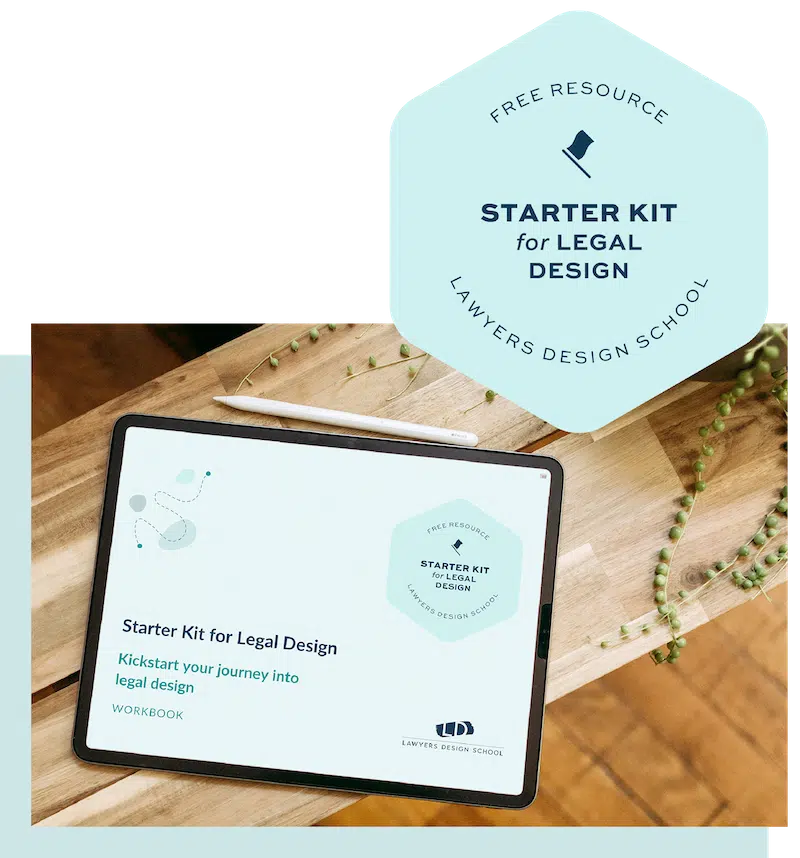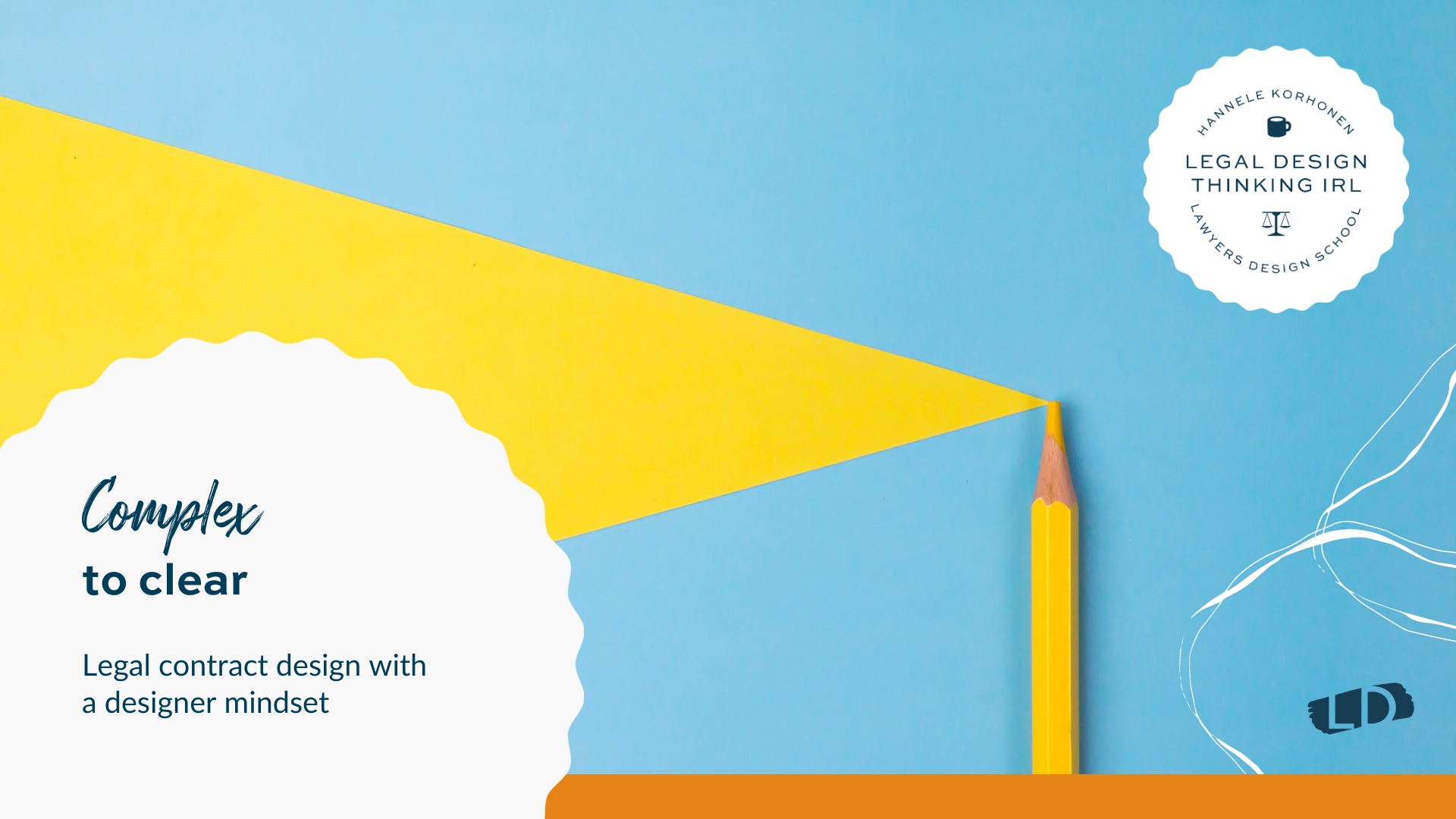What is contract design?
Contract design is about making contracts easier for users; to improve the usability and user experience from the user’s perspective.
Using legal design processes and tools we structure and present the content in a way the user will best understand and relate to the information.
Believe it or not, it’s your superpower for happy clients.
If you want to know more about contract design, check out our Contract Design School where you can learn everything you need to know about contract design: simplification, visualization and serve your clients the way you’ve always wanted to.
Why are user experience and contract design important?
Your user experience has a direct impact on your revenue.
Take a look at your firm’s “Terms and Conditions” document. Is it a wall of text with a tiny font, frustratingly complicated and boring? Thought so.
Now think about your client and their journey with you. You give them your terms to consider when you ask if they’d like to hire you, right?
They’re excited because their initial meeting with you was positive, they relate to you and feel like you’re the firm for them. Then you send them your terms and conditions to start the engagement and your potential new client is frustrated. They’ve got a terms and conditions document that’s intimidating, full of legalese and not relatable at all. Ugh.
Not a great first impression, right? And it hardly reinforces your brand as a modern, future-oriented, human-friendly law firm?
Are you making it easy for your clients to want to work with you?

STARTER KIT FOR LEGAL DESIGN
Free resource
Get this free resource to kickstart your journey into legal design.
Add empathy, simplicity, and creativity to your legal work and elevate customer experience.
Your contracts are your superpower
We spend a fortune on marketing and branding to woo and keep clients, but we’ve forgotten that our documents are a powerful way to delight and empower our clients. We give our clients documents every day, and every time we do, it’s another stage in their client experience. Why wouldn’t we use them to help our clients and create our point of difference? Our contracts are a key tool in our brand-building tool belt.
But still, most lawyers do not see this. They do not see contracts as an interaction, a communication channel and as a proactive tool to build client relationships. They see contracts as a necessary evil, tools to minimise risks and prepare for a trial. Lawyers think contracts are written like they are for a reason and they can’t be changed or improved.
The legal design thinkers disagree.
There’s so much we can do to improve our contracts while making sure they’re legally solid. User-friendliness and validity are not mutually exclusive.
What’s best, you don’t have to be a graphic designer or wizard with fancy software to be able to work on the design of your contract. And you don’t need a huge budget either.
Easy contract design tips that don’t cost a cent
Take a look at the Lawyers Design School Terms of Use as an example of an intentional contract design process.
Here’s the legal design process I followed to create them.
1. Start with the beef
Put the information most important to your client at the start of the document.
Don’t bury it. Don’t start with history and background information. Get to the point.
What does this technique look like in real life?
The Lawyers Design School’s terms and conditions start with the three most important pieces of information our clients need to know when they are purchasing a workshop. The beef is upfront and centre where clients can easily find it.
How do I know what is important to my clients? I asked them. Then answered the frequently asked questions and concerns at the very beginning.
In our case, it’s the cancellation policy. If someone has registered for a workshop, they want to know what happens if they cancel.
Cancellation policies aren’t great fun and no one likes to talk about them, but if you bury the details and your client doesn’t read them, does it help to build trust in your brand?
The more transparent you are with your legal stuff, the more trust you build and the stronger relationship you get as a result.
And hiding important clauses from your client is not good business. Unclear is bad business. If my client does not understand they will not buy.
This technique is very doable and doesn’t require any specific visual skills.
All you need is an understanding of your clients and what is important to them and a willingness to get clear and transparent with your legal text.
2. Create an action layer
Add extra elements to your terms and conditions to help your client to take the action the contract requires.
The philosophy behind this technique is that contracts have many different users.
Lawyers may use the terms and conditions to define our obligations and limit our liability. We may be obliged to include certain legal information in a certain format just to comply with the legal requirements.
But our clients’ needs are very different. They look at your terms and conditions to find information that is relevant for them and apply that information to their situation. If your client is an organisation there may be a number of people reading the same document.
How do you then serve multiple users in the same document?
You can create different layers for different users.
I learned this technique from Rob Waller who is an information designer at the Simplification centre. His research presents a layered model for future contracts that includes
- reference layer, meaning the full text,
- an explanation layer and
- an action layer that gives the client at-a-glance information of what is asked from them.
In the Lawyers Design School terms and conditions, you can see the layering technique used in the frequently asked questions table at the start of the document. Additionally, we included icons throughout the document to give that at-a-glance information.
We wanted to explain the core content in the format of questions and answers creating an explanation layer. And also added icons to different clauses to help our clients to find the relevant clauses without the need to read the entire text first.
This technique also requires a client-centered approach to understand the questions your clients have and where they need explaining. But it doesn’t require heavy investments or a graphic designer to make it happen. In fact, you could implement this technique right now.
If you haven’t already, start collecting data about the questions your clients have about working with you and your relationship. This will build your understanding of the content you want to highlight in your contracts as well. And from that understanding, you can create FAQ for your terms and conditions or other types of explanation and action layers.
3. Use a client-friendly tone of voice
Speak directly to your client in your terms and conditions and not some faceless mass of people.
Yes, this is possible in legal language.
There’s no law that says the legal language is only binding if it’s distant, formal, passive and devoid of personality. That’s just legacy talking.
Terms and conditions are one important interaction, a touchpoint, your client has with you. So why not surprise them with a friendly, personal touch. Why not design terms and conditions that are welcoming your client into your world in a friendly way.
In our terms and conditions in Lawyers Design School, I wanted to change the tone of voice entirely. I wanted to speak to my clients directly, in a kind and personal way.
The terms and conditions start with a greeting and then go on addressing my client taking account of their needs. This helps with engagement and makes users more likely to read the first paragraphs containing the most important information. Blind consents do not serve anyone.
This level of friendliness isn’t for everyone. I get that. Understanding your brand, how you want to be perceived and what your clients expect from you is important. So get to know your clients and look into your soul and brand before you design your language and tone. For some organizations, a more formal tone of voice may be better.
As long as the choice is deliberate and in the best interest of your clients, you’ll do fine.
So there you have it. Three techniques you can start using immediately in your own terms and conditions to make them easier for your clients. Could they use a “once over?”
Coffee with Hannele Korhonen: Happy customers & happy lawyers. Episode 15.
You’ve just read a summary of my Instagram Live session. I run them weekly for law firm owners who are looking for actionable advice and tips on how to get more happy clients and make themselves happy lawyers with the help of legal design thinking.
If you’ve read something that interests you, I’d be delighted to see you at the next session.
You can catch a replay of episode 15 here or join me live and ask questions.
Want to chat about it?
Is legal design feeling more reliable to you now? Is contract design something you think could add value to your client experience?
Feel free to DM any questions or join me on Instagram every Wednesday at 8 am ET where you can ask me about legal design and growing your law firm.
Follow me at @lawyersdesignschool and get more practical tips on building a thriving law firm, how to find new clients and become a happy boutique law firm owner.
Prefer email? Drop me an email at [email protected]. And while you’re here, take a peek at the Lawyers Design School and check out other ways to use legal design thinking to grow your law firm and thrive in your business.
Watch all the Happy customer and happy lawyers episodes.

STARTER KIT FOR LEGAL DESIGN
Free resource
Get this free resource to kickstart your journey into legal design.
Add empathy, simplicity, and creativity to your legal work and elevate customer experience.

